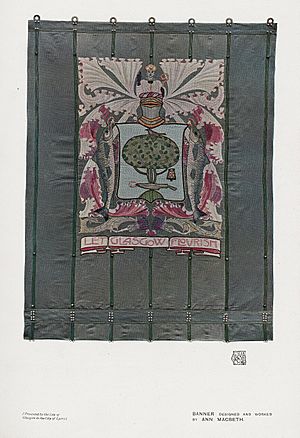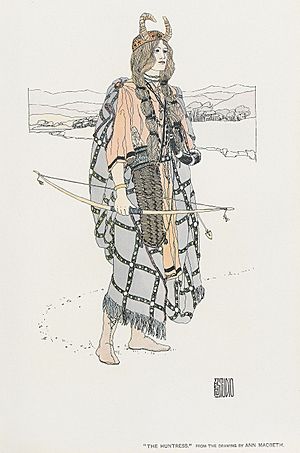Ann Macbeth facts for kids
Quick facts for kids
Ann Macbeth
|
|
|---|---|

c. 1900, Macbeth is wearing a self-made collar embroidered with the Glasgow rose.
|
|
| Born |
Annie Macbeth
25 September 1875 Bolton, Lancashire, England
|
| Died | 23 March 1948 (aged 72) Carlisle, Cumberland, England
|
| Nationality | British |
| Education | Glasgow School of Art |
| Known for | Embroidery |
| Movement | Glasgow Movement, Arts and Crafts movement |
Ann Macbeth (born September 25, 1875, in Bolton – died March 23, 1948, in Patterdale) was a talented British embroiderer, designer, teacher, and author. She was an important member of the Glasgow Movement. She also worked closely with the famous artist Charles Rennie Mackintosh. Ann Macbeth was a strong supporter of women's rights. She designed banners for groups that wanted women to have the right to vote.
Contents
Ann Macbeth's Early Life
Ann Macbeth was born in Halliwell, a part of Bolton. She was the oldest of nine children. When she was young, she had scarlet fever. Her father, Norman Macbeth, was an engineer. Her mother was Annie MacNicol.
Ann came from a family of artists. Her uncles, Robert Walker Macbeth and Henry Macbeth-Raeburn, were artists. Her grandfather, Norman Macbeth, was a portrait painter. In 1902, Ann won a silver medal at an art exhibition in Turin, Italy. She won it for designing a banner with the Glasgow Coat of Arms.
Ann Macbeth as a Teacher
After finishing her studies in 1901, Ann Macbeth became an assistant at the Glasgow School of Art. Her amazing embroidery work was often shown in The Studio magazine. In 1906, she began teaching metalwork there. She also taught bookbinding from 1907 to 1911. From 1912, she taught how to decorate ceramics.
From about 1902 to 1911, the needlework department was the biggest craft section at the Glasgow School of Art. All schoolgirls in Glasgow had to learn to sew. Ann Macbeth and her students made two main types of needlework. One was a bold, patterned style inspired by nature. This was used on everyday items. The other was more like a picture, seen on fire screens or church hangings.
In 1908, Ann Macbeth became the head of the Needlework and Embroidery section. By 1912, she was the Director of Studies for the Needlework-Decorative Arts Studio. She also helped plan the Scottish Exhibition of National History, Art and Industry in 1911.
Educational Needlecraft Book
In 1911, Ann Macbeth wrote a textbook called Educational Needlecraft with Margaret Swanson. This book was very popular around the world. It greatly changed how needlework was taught. The book was even used in Scottish schools until the 1950s.
Ann Macbeth's classes at the Glasgow School of Art were open to everyone. She taught Saturday classes for schoolteachers. These classes helped teachers get a certificate from the Scottish Education Department. Through her teaching, Ann Macbeth shared new ideas about design. She promoted the ideas of the Arts and Crafts movement.
She also encouraged women to make their own clothes. She showed them how to use simple materials like cotton and linen. This made designed dresses affordable for more women. Ann Macbeth wanted a new generation of women to become designers and craftswomen. She told them not to just copy patterns.
Ann Macbeth believed that using simple materials was better than expensive silks. She thought silks were "less artistic."
Teaching at the Women's Institute
From 1920, Ann Macbeth also taught handicrafts at the Women's Institute. She helped with programs to support local communities. In her book Embroidered and Laced Leatherwork, she noted that women often sold their crafts too cheaply. They barely covered the cost of their materials. Through her teaching, Ann Macbeth wanted to help craftworkers earn a living. She encouraged them to create unique regional styles.
Women's Rights Activism
Ann Macbeth was a strong supporter of women's right to vote, known as the suffrage movement. She designed banners for many important marches and groups. In 1908, she designed a banner for a march in Edinburgh. In 1909, she designed an embroidered banner for the Glasgow branch of the Women's Social and Political Union (WSPU). The WSPU was a group that took more direct action to gain voting rights.
For an exhibition in 1910, Ann Macbeth designed the WSPU Holloway Prisoners Banner. This was a linen quilt with the embroidered signatures of 80 suffragettes. These women had gone on hunger strike in prison. This quilt was later used as a banner.
Ann Macbeth was not just a banner maker; she was also an active member of the WSPU. She took part in their actions. Because of her activism, she was imprisoned. In a letter from May 1912, Ann Macbeth thanked the Glasgow School of Arts for their support. She mentioned that she was recovering after a difficult time in prison. The School's Governors were very supportive of her recovery. This showed they approved of artists supporting the suffrage cause.
Ann Macbeth's Artistic Work
Ann Macbeth became a very famous embroiderer and designer. She created many different things. These included bookbindings and metalwork. She also designed for carpet companies like Alexander Morton and Co. and Donald Bros. of Dundee. She even designed for Liberty's & Knox's Linen Thread Company.
For Liberty, Ann Macbeth created Art Nouveau style embroidery designs. These designs were in the company's mail order catalogs until World War I. Her designs were sold as iron-on transfers. People could use them to embroider dresses and furniture.
In 1920, Ann Macbeth moved to Patterdale in Westmorland, Cumbria. She continued to be a visiting lecturer at the Glasgow School of Arts until she retired in 1928. In Patterdale, she kept making needleworks, often large decorative designs. She also made church hangings and special clothes for priests. She decorated china and even built her own kiln to fire it.
She also created a simple way to weave rugs. She wrote about it in her 1929 book, Country Woman’s Rug. Ann Macbeth believed that machines could help make art available to more people. She thought craftworkers who understood machines could create high-quality art. In the summers, Ann Macbeth lived in a house she designed herself. She captured the local hillsides in her embroidery. Outside her house, she dyed her own yarn in special pits.
Where to See Ann Macbeth's Work
- You can see some of her embroideries at St. Patrick's Church in Patterdale, Cumbria.
- Her work was shown for a long time at Miss Cranston's tea-rooms in Glasgow.
- She designed and embroidered a special cloth for the communion table at Glasgow Cathedral.
- The Kelvingrove Museum in Glasgow has shown her work. This includes both her embroidery and ceramics.
- The magazine The Studio has many pictures of her work.
Images for kids
See Also








